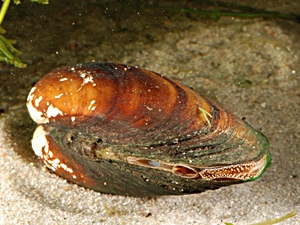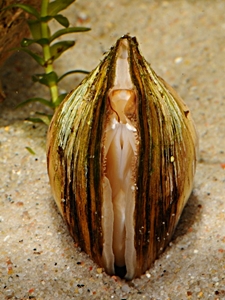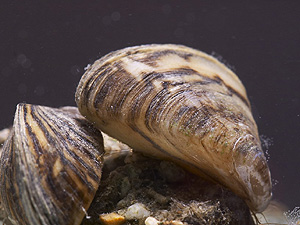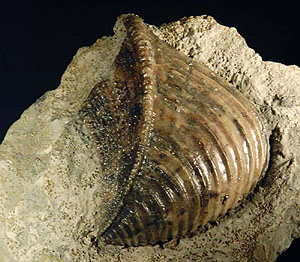Fresh Water Bivalves
| |
| Class |
Species No. |
| Snails (Gastropoda) |
43.000 |
| Mussels (Bivalvia) |
10.000 |
| Squids (Cephalopoda) |
650 |
| Elephant Tusks (Scaphopoda) |
600 |
| Neopilina (Tryblidia) |
20 |
| Chitons (Placophora) |
750 |
| Solenogastres |
230 |
| Caudofoveata |
120 |
|
|
| Molluscs (Mollusca) |
55.400 |
Species number of molluscs.
 Diagram.
Diagram. |
|
Gastropods and bivalves are the only molluscs that, apart from the sea, can be
found also in fresh water: In rivers and creeks, ponds and lakes. While
life conditions in the sea, perhaps except for the coastal areas, are rather
uniform, habitats on land show a mosaic of small ecological spaces, varying with
area and time and so requesting a strong ability to adapt from their inhabitants.

Painter's mussel (Unio pictorum).
Picture: Niels Sloth,
Biopix.dk. |
|
In the course of evolution this has caused the consequence that groups
related to each other become isolated by ecological adaptation, which leads to
the development of species and to the evolution of a large number of species
especially adapted to the varying ecological conditions. Because of that,
terrestrial and fresh water snail species are much more numerous, the same is
the case with bivalves.
Compared to the exclusively sea-living rest of the mollusc classes,
gastropods and bivalves make by far the largest portion of species (see table).
Of the about 55,400 species of molluscs known as of today, gastropods and
bivalves contain 53,000 species, of which 43,000 are gastropods, the only class
also living on land – that is more than three quarters of all known mollusc
species.
The Central European fresh water bivalves by their size and form can be
divided in two groups, all of which have different roots in sea-living groups:
Larger mussels or naiads:
| |

Duck mussel (Anodonta anatina).
Picture: Niels Sloth,
Biopix.dk. |
The relatives of river mussels (Unionacea) are the largest molluscs on Earth
outside of the sea. The largest Central European species is the large pond
mussel of swan mussel (Anodonta cygnea). It may grow to a size of up to 26 cm.
Among the relatives of river mussels, apart from pond mussels, there are also
the river mussels (Unio) and the fresh water pearl mussels (Margaritifera). Especially
concerning their larval development, those mussel groups are very different from
their sea-living relatives. They develop past a parasitic larval stage called a
glochidium. To be able to develop into juvenile mussels, glochidia need a certain species
of host fish in whose tissue they can remain to grow.
The relatives of river mussels also are referred to as naiads. This
uncommonly poetical term points to the world of ancient Greek mythology, where
naiads were fountain goddesses, among other things seeing to the cleanness of
their creek. In a similar way, like
blue mussels in the Wadden Sea, the large
river mussels have a great importance for the cleanness of the water they live
in.
 Further information on large fresh
water mussels.
Further information on large fresh
water mussels.

Zebra or wandering mussels (Dreissena polymorpha).
Picture:
Lars Peters. |
|
Lesser mussels:
Pea mussels and fingernail clams (Sphaeriacea) on the other hand are the
smallest mussels on Earth, the largest Central European species is the river
fingernail clam (Sphaerium rivicola) with a shell maximally 25 mm in size. Most
pea clams are noticeably smaller; the largest pea clam species is Pisidium
amnicum with 7 – 11 mm. Fingernail and pea mussels are hermaphrodites and
reproduce by ovovivipary, larvae hatching inside the female's body. Juvenile
clams are finally born.
The relatives of wandering mussels (Dreissenacea) were much richer in species
during the Tertiary. Similar to blue mussels, they produce a byssus thread, by
which they can attach themselves to the ground. That way the wandering mussel (Dreissena
polymorpha) was able to spread on ships from the Caspian Sea region over all of
Europe, even to America.
| |

Trigonia sp., a fossil bivalve from the Trigoniacea, today's
large mussels' ancestors. Picture:
Armin Bauer. |
Today this bivalve species invades waters almost everywhere and may become a
pest, as it not only overgrows stones and rocks, but also other mussels,
crayfish and other animals. The wandering mussel may also inflict economical
damage, when it jams water power plants and dams.
 Further information on lesser fresh
water mussels.
Further information on lesser fresh
water mussels.
Systematics
Systematically, larger and lesser mussels are in two different subclasses of
the mollusc class Bivalvia.
The larger mussels are in the Palaeoheterodonta subclass evolved since the
Mesozoic. Present day's only sea living relatives of this subclass are the Trigoniacea, a small group, the remainder of which can be found near Australia.
The relatives of river mussels make an own order, the Unionoida.
In contrary to that, the lesser mussels belong to the subclass Heterodonta,
together with sea-living relatives, such as clams (Veneracea) and cockles (Cardiacea).
The relatives of fingernail clams (Sphaeriacea) and wandering mussels (Dreissenacea)
together with Venus clams belong to the Veneroidea order.



